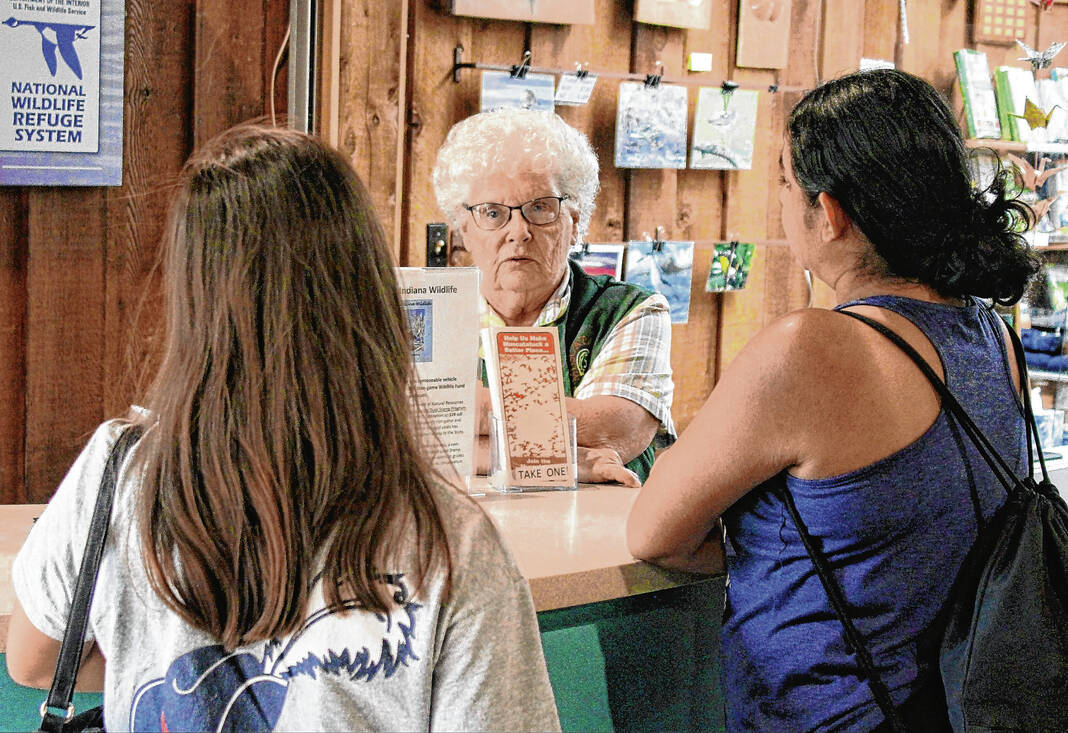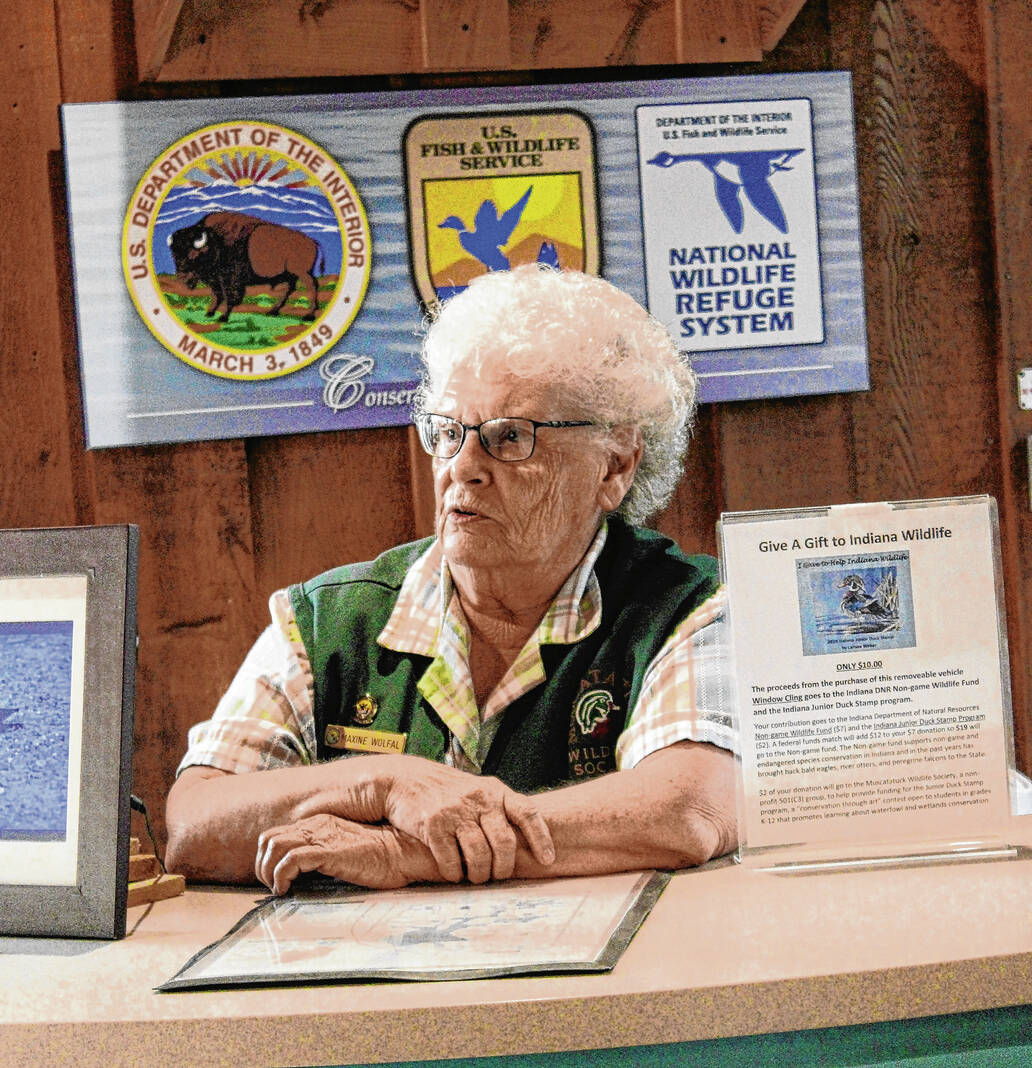
Maxine Wolfal offers hiking advice to visitors at Muscatatuck National Wildlife Refuge.
Lew Freedman | The Tribune

Muscatatuck National Wildlife Refuge ranger Donna Stanley calls Maxine Wolfal, who staffs the visitor center, “the champion” volunteer.
Lew Freedman | The Tribune

Maxine Wolfal of Columbus has volunteered 11,000 hours worth of time at Muscatatuck National Wildlife Refuge in Seymour.
Lew Freedman | The Tribune
Maxine Wolfal might not be able to name every individual tree in the forest within Muscatatuck National Wildlife Refuge, but she can probably tell a visitor where to find every kind of tree inhabiting the 7,724 acres while hiking.
Wolfal, 85, of Columbus has volunteered her services at Muscatatuck for 30 years and has put in 11,000 hours of time. That’s why ranger Donna Stanley calls Wolfal the refuge’s “champion” volunteer.
On a recent sunny Saturday, the white-haired and chatty Wolfal sat behind an information counter in the refuge visitor center, ready to dispense brochures, advice and even small packets of sunscreen for those who arrived in the woods unprepared for powerfully strong rays.
Wolfal was staffing the gift and book store that highlights Indiana nature topics on birding, plants, trees and more.
It is said about 280 species of birds can be viewed in Muscatatuck, including the Indiana state bird — the cardinal — and deer, squirrels, otters and more on the wildlife front. Once, Wolfal saw a bobcat.
She has long desired to see a black bear in Muscatatuck. Officially, black bears do not reside in Indiana, although it would not shock Indiana Department of Natural Resources authorities if they eventually return, and they have been known to occasionally pass through.
“I want to see a black bear here so badly I can’t stand it,” Wolfal said. “When I went to Maine, my son promised me I would see a black bear, and I didn’t.”
Spotting a black bear in the refuge lurks on Wolfal’s life list. The bobcat sighting ranks high as a favorite wildlife moment, though.
“That was just fun because it was so unexpected,” Wolfal said.
Over the decades, Wolfal volunteered at the refuge along with her late husband, Mark, “for years and years” every Saturday. But there also were stretches when she has helped out two or three times a week.
River otters were reintroduced to Muscatatuck in 1995, and Wolfal said that was a thrill to see. The otters are popular residents of the refuge for the casual visitor or professional wildlife photographers who make regular visits.
A photographer from Louisville, Kentucky, who was a newcomer to Muscatatuck stopped by to speak with Wolfal and told her he just hoped to try out a new lens. Less than a mile down the road, another man was cradling his bazooka-sized lens carefully, on the prowl for something moving in the brush. A woman who was a regular shooter also stopped in to see Wolfal and was greeted by name.
Over the years, Wolfal has been the worker who recommended what books to stock in the gift shop, many of them emphasizing the flora and fauna of Indiana.
“I try to find things that are not in regular bookstores,” she said.
When a visitor walks in the front door, they are asked where they are from and what they are interested in doing in the refuge.
Two women from Chicago, Illinois, made Muscatatuck a spontaneous stop on a drive, and Wolfal helped them out with the sunscreen, the size of the package about the same size as restaurant salad dressing.
“All of these trails are easy,” Wolfal informed them about hiking prospects.
A group of four — two adults and two children — popped in from Indianapolis. They had been there before. MaryAnn O’Hara is a Muscatatuck fan, telling friends in the big city about the place.
“It’s a hidden gem,” she said, stressing the nature. “Look at what you’re missing.”
The girls accompanying her appeared to be around 10 to 12. Wolfal posed for pictures with them, and when they were poised to begin their hike, she instructed them, “If you see a dinosaur, you come tell me.”
If there was a brontosaurus or any other blast-from-the-past dino camouflaged in the trees or bushes or sipping water from Stanfield Lake, it would be difficult to contain the news only to Wolfal.
Wolfal wasn’t counting on such a report. People are excited enough when they see tundra swans, and even if they can’t readily identify every animal they see blending into the woods, they do not make outlandish claims.
“No one has ever told me they saw Bigfoot,” Wolfal said.
No, but she won’t dismiss a report of an alligator out of hand, just in case someone dumped it at the refuge because it had outgrown their home.
Wolfal may not be capable of identifying every form of wildlife at a glimpse, but she is super knowledgeable about the refuge’s inhabitants, Stanley said.
“She’s so involved in engaging people with the refuge,” Stanley said. “She wants people to know everything about the refuge. She is enthusiastic about the refuge. We think a lot of Maxine. She is a wonderful volunteer.”
Wolfal has spent so much time at Muscatatuck — those 11,000 hours represent a tremendous connection — she has become somewhat of an expert birder, although she is not like many aggressive birders who travel the world to catch a glimpse of as many of the many thousands of species as possible. She cared enough, however, to obtain a birding phone app that helps identify birds by their chirps.
Although Wolfal said she has not kept an accurate life list, common practice among birders, she admits to having seen “hundreds, not thousands” of species.
“I love it,” Wolfal said. “I know birds pretty well.”
Wolfal does chuckle when a refuge visitor enters the center and asks, “Where can I find birds?”
Usually, the correct answer is to just look out the back door at the bird feeders. Or step out the front door of the center and stand still and listen. The birds at the refuge will find you, and Maxine Wolfal can probably tell you what they were.
